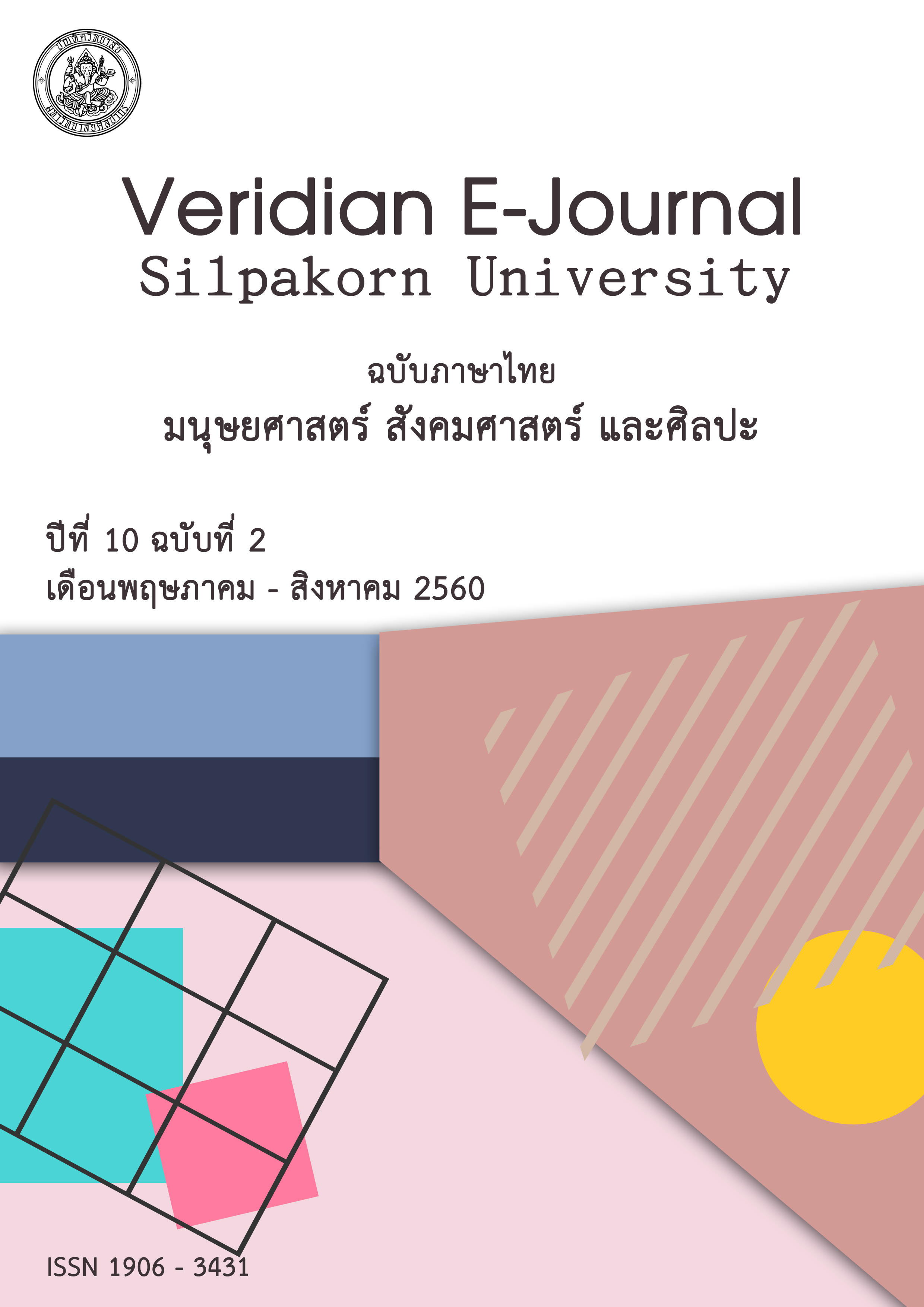การพัฒนาหลักสูตรฝึกอบรมหัวหน้างานสายการผลิตโรงงานผลิตสินค้าเคมีเกษตร
Main Article Content
Abstract
การวิจัยในหัวข้อเรื่อง การพัฒนาหลักสูตรฝึกอบรมหัวหน้าสายการผลิตกลุ่มโรงงานผลิตสินค้าเคมีเกษตร มีวัตถุประสงค์ของการวิจัยเพื่อศึกษาองค์ประกอบสมรรถนะที่สำคัญในการปฏิบัติงานและเพื่อพัฒนาหลักสูตรฝึกอบรมหัวหน้าสายการผลิตโรงงานผลิตสินค้าเคมีเกษตรในเขตจังหวัดนนทบุรี เครื่องมือที่ใช้ในการเก็บรวบรวมข้อมูลได้แก่ แบบสอบถามและแบบสัมภาษณ์ การวิเคราะห์ข้อมูลด้วยโปรแกรมคอมพิวเตอร์สำเร็จรูปทางสถิติ ผลการวิจัยพบว่า
- องค์ประกอบสมรรถนะในการปฏิบัติงานของหัวหน้าสายการผลิต ผู้วิจัยเริ่มจากการวิจัยเชิงคุณภาพด้วยการสัมภาษณ์เชิงลึกกับผู้บริหารระดับสูงและผู้จัดการฝ่ายทรัพยากรมนุษย์ จำนวน 5 คน และการวิจัยเชิงปริมาณด้วยแบบสอบถาม กลุ่มตัวอย่างที่ใช้ในการวิจัยครั้งนี้ คือ หัวหน้าสายการผลิตในโรงงานผลิตสินค้าเคมีเกษตร จำนวน 346 คน คิดเป็นร้อยละ 54.66 ซึ่งเป็นไปตามเกณฑ์ที่ถือว่ายอมรับได้ โดยใช้โปรแกรมสำเร็จรูปทางสถิติในการวิเคราะห์องค์ประกอบเชิงยืนยัน (Confirmatory factor analysis) และการทดสอบโมเดลของสมรรถนะหัวหน้าสายการผลิตเพื่อวัดความสอดคล้องกับข้อมูลเชิงประจักษ์โดยใช้โปรแกรมลิสเรล ผลการวิจัยพบว่า องค์ประกอบสมรรถนะที่สำคัญของหัวหน้าสายการผลิตในโรงงานผลิตสินค้าเคมีเกษตร ประกอบด้วย 6 สมรรถนะ ได้แก่ ความเป็นผู้นำ การสั่งการ การจูงใจ การสอนงาน การบริหารความเสี่ยง และการยศาสตร์
2. การพัฒนาหลักสูตรการฝึกอบรมหัวหน้าสายการผลิตกลุ่มโรงงานผลิตสินค้าเคมีเกษตร เป็นการพัฒนาหลักสูตรการฝึกอบรมระยะสั้นระหว่างการปฏิบัติงาน (On the job training) โดยนำแนวคิดการพัฒนาหลักสูตรของ Taba, Hilda, and Willard B Spalding. (1962) มาสรุปย่อกระบวนการเป็น 5 ขั้นตอน ได้แก่การวิเคราะห์ความต้องการ การตั้งวัตถุประสงค์ การเลือกและจัดระบบเนื้อหาวิชา การเลือกและการจัดประสบการณ์เรียนรู้ และการวัดและการประเมินผล การประเมินความสอดคล้องของร่างหลักสูตรฝึกอบรมที่ได้พัฒนาขึ้น โดยผู้ทรงคุณวุฒิ จำนวน 5 ท่าน ประกอบด้วย ผู้บริหารระดับสูง ผู้จัดการฝ่ายทรัพยากรมนุษย์ นักวิชาการด้านหลักสูตร และนักวิชาการด้านสมรรถนะ พบว่า มีค่าดัชนีความสอดคล้อง (Index of item objective congruence : IOC) เท่ากับ 0.60-1.00 ในประเด็นของหัวข้อหลักสูตรการอบรมมีสอดคล้องกับหลักสูตรฝึกอบรม วัตถุประสงค์เชิงพฤติกรรมมีสอดคล้องกับหัวข้อหลักสูตร หัวข้อเนื้อหาการอบรมมีความสอดคล้องกับหัวข้อหลักสูตร วิธีการอบรบมีสอดคล้องกับวัตถุประสงค์เชิงพฤติกรรม สื่อประกอบการอบรมมีสอดคล้องกับวัตถุประสงค์เชิงพฤติกรรม การประเมินผลการอบรมสอดคล้องกับวัตถุประสงค์เชิงพฤติกรรม และระยะเวลาการอบรมมีสอดคล้องกับหัวข้อหลักสูตร แสดงว่า โครงร่างหลักสูตรมีความสอดคล้องกันทุกรายการ
- ผลสัมฤทธิ์ในการฝึกอบรมหลักสูตรพัฒนาหัวหน้าสายการผลิตกลุ่มโรงงานผลิตสินค้าเคมีเกษตร จากการทดลองใช้กรณีศึกษาของบริษัทเอกชนแห่งหนึ่งในเขตพื้นที่จังหวัดนนทบุรีที่เปิดดำเนินการมามากกว่า 5 ปี มีผู้เข้ารับการฝึกอบรมเป็นหัวหน้าสายการผลิต จำนวน 7 คน โดยใช้หลักสูตรการพัฒนาสมรรถนะด้านความเป็นผู้นำ ระยะเวลาที่ใช้ในการฝึกอบรม 3 ชั่วโมง ผลสัมฤทธิ์จากการทดสอบก่อนการฝึกอบรม ได้คะแนนรวมเฉลี่ย 67.0 คะแนน จากคะแนนเต็ม 100 คะแนน โดยมีคะแนนเฉลี่ยสูงสุดในหัวข้อหลักการควบคุมและทักษะการควบคุมการผลิต และเมื่อทดสอบหลังการฝึกอบรม ได้คะแนนเฉลี่ยรวม 96.5 คะแนน โดยมีคะแนนเฉลี่ยสูงสุดในหัวข้อ ภาวะผู้นำของผู้บริหาร หลักการควบคุมและทักษะในการควบคุมการผลิต ดังนั้นเมื่อเปรียบเทียบคะแนนเฉลี่ยหลังการฝึกอบรมและก่อนการฝึกอบรม พบว่า ผลสัมฤทธิ์ในการเรียนของหัวหน้าสายการผลิตสูงขึ้น ค่าเฉลี่ยหลังการฝึกอบรมสูงกว่าก่อนการฝึกอบรมเท่ากับ 29.5 คะแนน
The reacher on training curriculum development aimed to study major contributors to key competency of chief officers in production line of agricultural chemical factory in Nonthaburi Province. Research tools used included questionnaires, interview and statistical analyses through computer softwares. Results suggested as follows:
- To measure key competency of supervisory staffs of production lines, 5 chief executive officers were selected for an in-depth interview and 346 supervisory staffs were also adequately sampled for questionnaires accounting for approximately 54.66% of working personnels. Confirmatory factor analysis (CFA) was performed through statistical computer software and competency model was also confirmed using Lisrel Packages for significant correlations between empirical data. CFA revealed that leadership, command, motivation, coaching, risk management and ergonomics were major contributors toward key competency.
- This curriculum development emphasized on a short, in-service or on-the-job training by adapting the principles of curriculum development authored by Taba and Spalding (1962). These involved 1.) appraisal of training need, 2.) erecting objectives, 3.) selecting and organizing subject content, 4.) organizing learning experience and 5.) assessment and evaluation. For content validity and coherence, a tentative training curriculum was evaluated by 5 experts which consisted of chief executive officer, human resource manager, curriculum developer and competency expert. Index of item objective congruence (IOC) was estimated between 0.60 and 1.00. The content of the training curriculum was consistent with the training curriculum. Behavioral objectives were consistent with the curriculum. Topics in the course were consistent with the curriculum. The teaching method was consistent with the behavioral objectives. The training materials were consistent with the behavioral objectives. Evaluation of the training corresponded to the behavioral objectives as well. The duration of the training was also in line with the curriculum, indicating that the curriculum was consistent throughout.
- For assessment of achievement in training course on development of chief officers of production line of agricultural chemical factory, based on a case study of a private company in Nonthaburi province, which has been in business for more than 5 years, 7 trainees were selected from the chiefs of production line in agricultural chemical plant. The Excellent Leadership Development Program was tried with a duration 3 hours. Pre-training achievement was assessed and the average score was 67.0 points out of a 100 points, with the highest average score in the topics of production control. For post-training achievement, the average score was 96.5 points, with the highest average score on the topics of definition of leadership of manager, principles of production control skills. Therefore, when comparing the average pre- and post-training scores, it was found that the overall achievement of the curriculum was that the chiefs officers of the production line attending the training had higher learning achievement. The average post-training score was 29.5 points higher than the average post-training.

